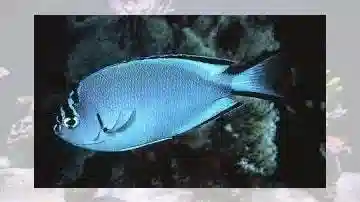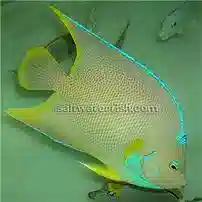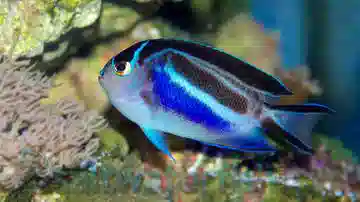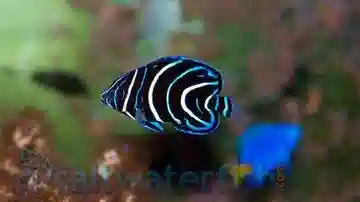Singapore Angelfish
Chaetodontoplus mesoleucus
(3 Reviews)

Singapore Angelfish
Chaetodontoplus mesoleucus
(3 Reviews)
{{ item.name }}
Size: {{ item.extra_field_3 }}
${{ getFormattedPrice(item.saleprice) }} ${{ getFormattedPrice(item.price) }}
To join the waiting list, click here
Free Shipping
With
$199.00
or more in Marine Life.
More details...
Singapore Angelfish Care Facts
| Care Level: | Moderate |
|---|---|
| Temperament: | Semi-aggressive |
| Diet: | Omnivore |
| Reef Safe: | No |
| Minimum Tank Size: | 120 gallons |
| Max Size: | 7 inches |
Singapore Angel (Chaetodontoplus mesoleucus) - A Comprehensive Guide for Saltwater Marine Aquariums
Habitat of the Singapore Angel
The Singapore Angel, scientifically known as Chaetodontoplus mesoleucus, originates from the Indo-Pacific region. These vibrant fish are commonly found in coral-rich areas, including reef slopes and lagoons. In the wild, they often swim among coral formations, seeking shelter and food.
Is the Singapore Angel Reef Safe?
The Singapore Angel is not considered reef-safe. While they are generally compatible with various coral species, their diet primarily consists of sponges, which could pose a risk to certain corals in a reef aquarium. Therefore, careful consideration and monitoring are necessary when housing them in a reef setup.
Size of the Singapore Angel
Singapore Angels typically reach a size of about 6 to 8 inches (15 to 20 centimeters) when fully mature. This moderate size makes them suitable for larger aquariums with sufficient swimming space.
How Long Does the Singapore Angel Live?
With proper care and a suitable environment, Singapore Angels can live for an average of 7 to 10 years in captivity, making them a long-term addition to marine aquariums.
What Should You Feed the Singapore Angel in Captivity
Singapore Angels are omnivorous and have a diverse diet in the wild. To maintain their health and vibrancy in captivity, it is crucial to provide a well-rounded diet that includes:
- High-quality marine flake or pellet foods
- Frozen or live foods such as brine shrimp, mysis shrimp, and finely chopped seafood
- Sponge-based feeds or supplements to mimic their natural diet
Offer a variety of these foods to ensure they receive adequate nutrition and provide multiple small feedings throughout the day.
Aquaculture Availability of the Singapore Angel
Singapore Angels are unavailable through aquaculture efforts, so most specimens available in the aquarium trade are still wild-caught. Due to their wild capture, sourcing them from reputable suppliers who prioritize sustainable and ethical practices is essential.
Sexual Dimorphism of the Singapore Angel
Singapore Angels do not exhibit significant sexual dimorphism, with males and females appearing similar in size and coloration.
Symbiotic Relationships of the Singapore Angel
Singapore Angels often form symbiotic relationships with coral formations in their natural habitat. They seek shelter among corals, providing them with protection and food sources while potentially benefiting them by deterring coral predators.
Juvenile vs. Adult Color of the Singapore Angel
Juvenile Singapore Angels sport a more muted coloration with predominantly white bodies and subtle black stripes. As they mature into adults, their colors become more vibrant, featuring a stunning contrast of deep blue and bright yellow.
Compatibility of the Singapore Angel
When considering Singapore Angels for your saltwater aquarium, compatibility with other tank inhabitants is crucial to maintaining a harmonious environment.
Temperament of the Singapore Angel
Singapore Angels are generally considered peaceful, although individual temperament can vary. However, they may become territorial, especially if kept in smaller tanks or alongside other angelfish species. Careful selection of tank mates and ample hiding places can help mitigate territorial behavior.
Suitable Tank Mates for the Singapore Angel
Here are five compatible tank mates that can potentially coexist peacefully with Singapore Angels:
- Clownfish (Amphiprion spp.): These popular, colorful fish are known for their peaceful disposition and can share a tank with Singapore Angels.
- Firefish Goby (Nemateleotris spp.): These slender gobies are peaceful and make excellent companions in a community tank.
- Yellow Tang (Zebrasoma flavescens): Known for their peaceful nature and vibrant coloration, these tangs are often compatible with Singapore Angels, especially in larger tanks.
- Cleaner Shrimp (Lysmata amboinensis): These invertebrates can contribute to maintaining a clean and healthy aquarium environment while posing no threat to Singapore Angels.
- Various Soft Corals: Consider incorporating different soft corals in your aquarium, as they can complement the aesthetics of the tank and provide additional hiding spots for Singapore Angels.
Tank Requirements for the Singapore Angel
Creating an ideal environment is crucial for the well-being of Singapore Angels. Here are some essential tank requirements:
- Minimum Tank Size: A tank with a capacity of at least 120 gallons is recommended to provide ample swimming space and accommodate the moderate size of Singapore Angels.
- Aquascaping: Incorporate live rock structures and coral formations to mimic their natural habitat and offer hiding places. Provide adequate open swimming areas in the front of the tank.
- Lighting: Moderate to high-intensity lighting is preferable, as it supports the health of photosynthetic organisms in the tank.
- Water Conditions: Maintain stable water conditions with the following parameters:
- pH: 8.1 to 8.4
- Salinity: 1.020 to 1.025
- Water Temperature: 74°F to 80°F (23°C to 27°C)
- Water Flow: Provide moderate water movement and ensure calmer water for resting and feeding areas.
Why People Should Buy the Singapore Angel from Saltwaterfish.com
When acquiring Singapore Angels, sourcing them from reputable and responsible suppliers like Saltwaterfish.com ensures that you receive healthy specimens that have been well-cared for. Such suppliers prioritize the ethical and sustainable collection of marine life, contributing to protecting these beautiful species in the wild.
In conclusion, the Singapore Angel (Chaetodontoplus mesoleucus) is a stunning addition to saltwater marine aquariums, known for its vibrant coloration and captivating presence. Their dietary habits should be carefully monitored in reef setups. These fish can live a decade or more in captivity with proper care. When considering Singapore Angels for your aquarium, ensure you provide suitable tank mates and meet their specific requirements. Purchasing them from reputable sources like Saltwaterfish.com ensures the ethical acquisition of these beautiful fish for your marine aquarium, supporting the sustainability of the aquatic aquarium hobby.
Reviewed by: Amber Tyler on July 8, 2024
Reviewed by: Lynn Adams on Nov. 27, 2023
The first Singapore Angelfish arrived DOA but they refunded me quickly and the second one arrived and I could not be happier. Grateful for the good service and the speed they replaced the DOA.
Reviewed by: Brad Smallwood on Sept. 11, 2021












